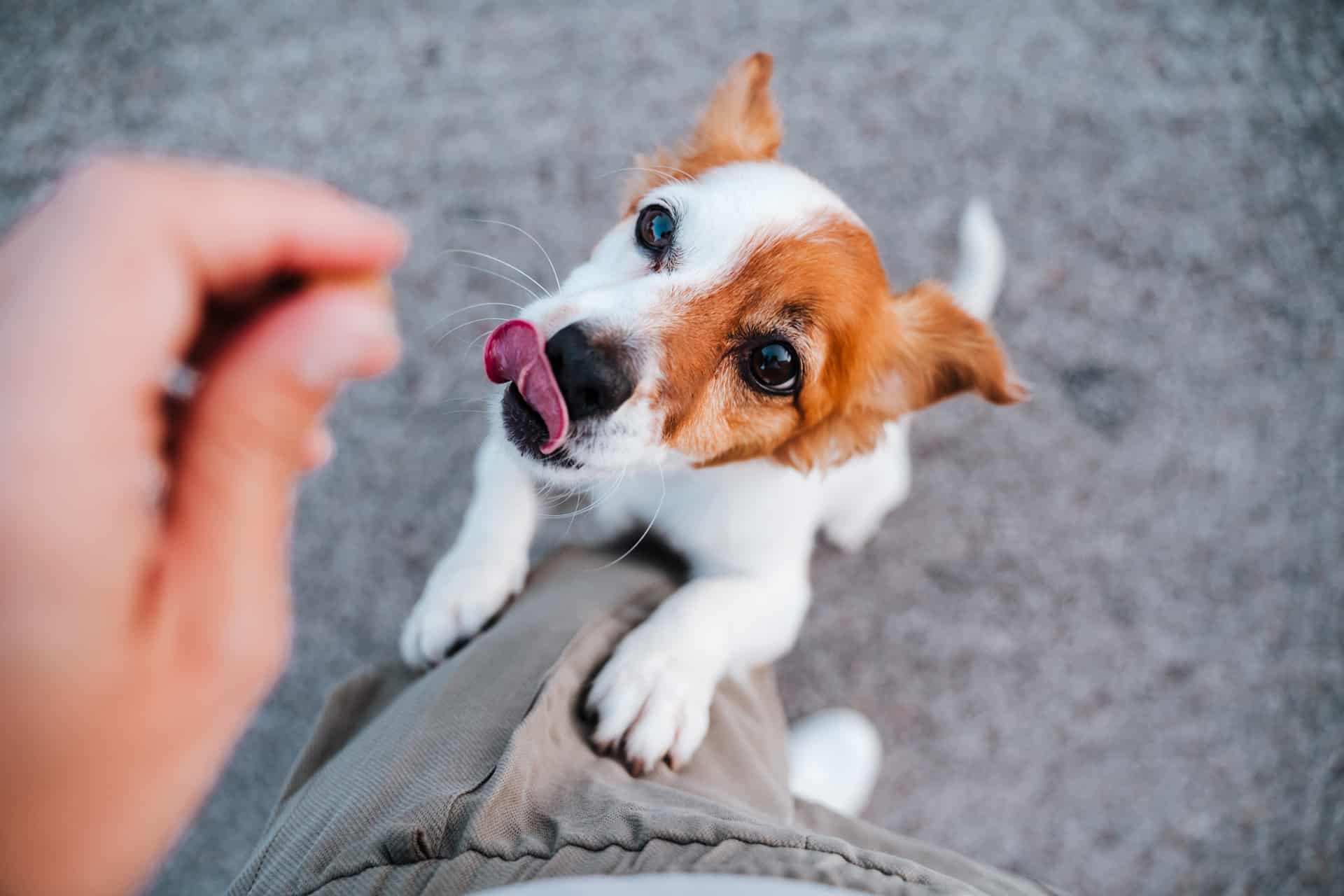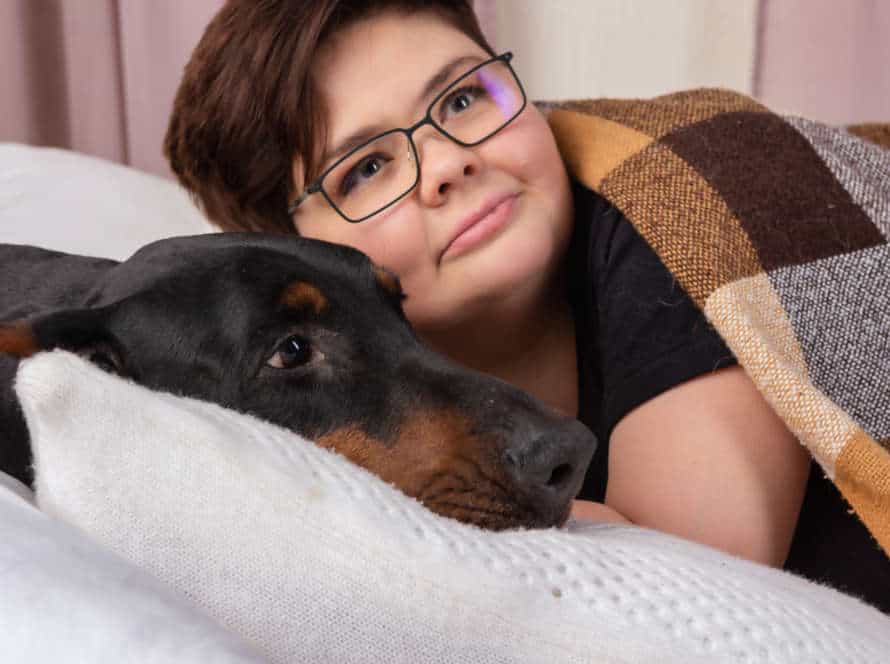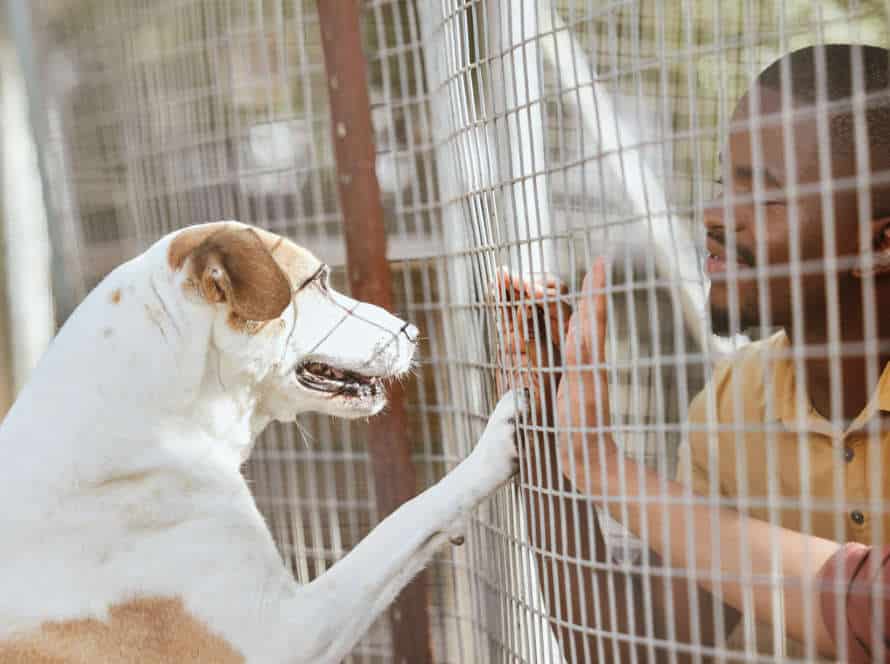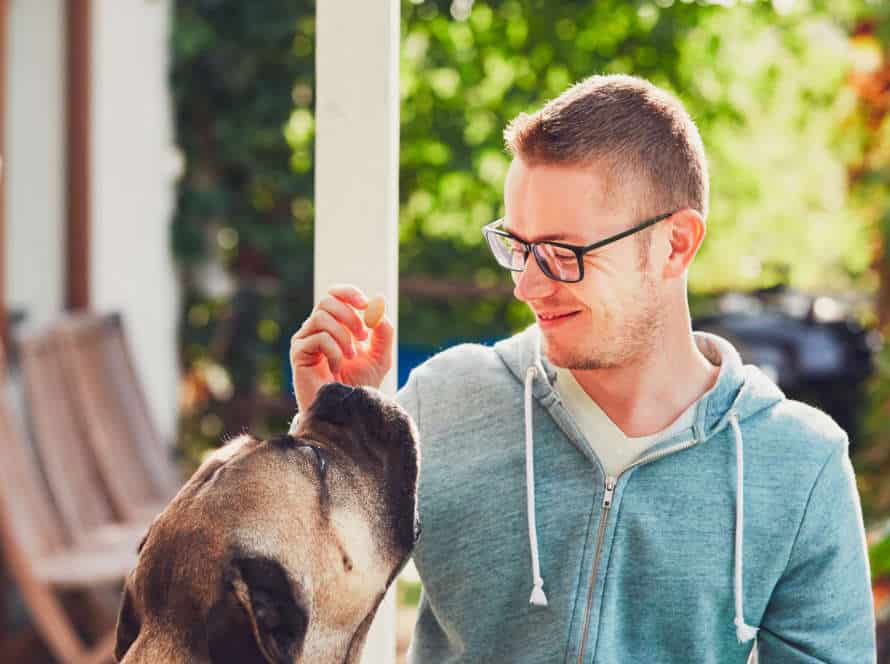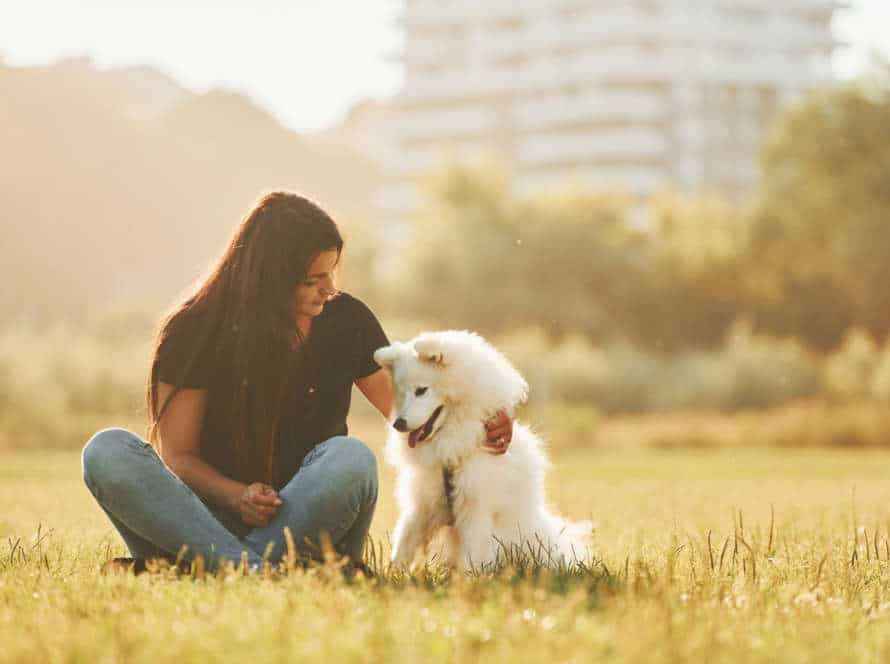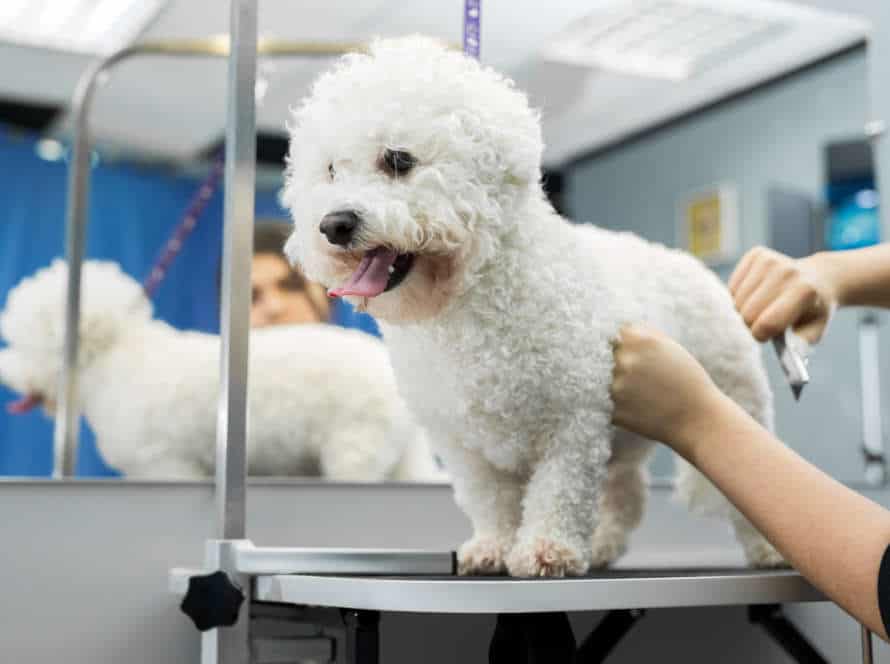Start Your Puppy Off Right with Positive Reinforcement Training
Positive reinforcement training is an awesome way to teach your pup great habits from the start. Here are some tips to help you get going:
- Use praise and treats as rewards for correct behavior. This will create a good connection with the wanted behavior, and motivate your pup to do it again.
- Keep training sessions fun & short. Pups have limited attention spans and get sidetracked easily, so it is crucial to make it enjoyable.
- Be consistent with your verbal cues and rewards. Use a clear and easy-to-understand command for each behavior you want your pup to learn. Give treats and praise every time they respond right.
- Remember – positive reinforcement training requires time and patience. Your pup may not learn everything overnight, so stay positive and keep practicing.
- Pro tip: Sign up for a puppy training class or work with an experienced trainer to help you and your pup get the best from positive reinforcement training.
Importance of Positive Reinforcement Training for Puppies
Positive reinforcement training is a great way to start your puppy off. It strengthens the bond between you and your pup, and helps them accept you as their leader. This type of training rewards good behavior and provides consequences for bad. It’s important for puppies, since it teaches them the right social behaviors.
In this article, we’ll explain why positive reinforcement should be the cornerstone of your pup’s upbringing.
Understanding Positive Reinforcement Training Methods
Positive reinforcement training is the most humane and effective way to train puppies. Treats, praise and other rewards can help teach puppies what’s desirable and make them do it again.
Why is it so important?
- It builds a strong bond between puppy and owner. They learn to trust and form a strong connection.
- It encourages good behavior. Positive reinforcement trains puppies to understand what’s expected of them.
- It boosts their confidence and reduces fear. Instead of punishing them, it makes them more confident and helps them face their fears.
- It improves overall well-being. Positive reinforcement creates a happy and healthy environment for puppies.
Start your pup off right with positive reinforcement techniques! Pro tip: give small, soft treats as a reward during training to keep them motivated.
Benefits of Positive Reinforcement Training over Punishment-based Training
Positive reinforcement-training is much better for puppies than punishment-based training. Positive reinforcement involves rewarding good behavior, whereas punishment-based training focuses on correcting bad behavior.
Benefits of positive reinforcement:
- Builds a strong bond between puppy and trainer.
- Encourages good behaviour in puppies.
- Gives longer lasting results.
- No negative side effects.
Pro tip: Start your puppy’s training with positive reinforcement early on to create a strong connection and encourage positive behaviour.
Common Mistakes to Avoid in Positive Reinforcement Training
Positive reinforcement training is a great way to train puppies. But, there are some mistakes we should avoid. Here are a few:
- Timing: Give rewards quickly after good behavior.
- Too many treats: If you give too many treats, puppies will expect them for everything. Slow down, and use verbal praise or pets instead.
- Inconsistent: Be consistent with commands and rewards. Everyone in the house should be on the same page.
Avoid these errors and you will have a strong bond with your puppy. Plus, less negative behavior!
Pro tip: Positive reinforcement isn’t just for puppies. It’s good for all doggies!
Essential Skills to Teach Your Puppy
It’s a must for responsible pet owners to teach their puppies essential skills. Positive reinforcement training is ace for this, as it rewards good behavior and makes learning fun! In this article, we’ll talk about the essential skills that you should teach your puppy. Use positive reinforcement when you do!
Teaching Basic Commands like “Sit”, “Stay” and “Come”
It is vital to instruct your pup basic commands like “sit,” “stay,” and “come” for successful communication and setting up a strong base for later training. Positive reinforcement is the finest method to teach your pup these abilities and build a lasting bond.
Here are some suggestions for teaching these fundamental commands:
- “Sit”: Show your pup a treat slightly above their head, to make them lift their head and sit down. Give them the treat or verbal approval when they do.
- “Stay”: After your pup has learned to sit on order, train them to remain in that position. Start by saying “stay” and rewarding them when they stay in a seated status for a few seconds. Step by step increase the period of the stay and bring in diversions.
- “Come”: Use a treat or toy to get your pup to come to you, giving them a reward when they reach you. Practice this command in a secure, enclosed spot until your pup is consistent.
Pro tip: Keep training sessions short and enjoyable, and always end on a positive note to keep your pup intrigued and eager to learn.
Step-by-Step Guide to Teach “Sit” Command
Teaching your pup the “sit” command is key. Here’s a step-by-step guide to help.
- Find a quiet, undistracted location.
- Take a treat. Hold it near your pup’s nose.
- Move the treat up and back. This will make your pup’s nose point up and their butt lower. Say “sit” and give them the treat.
- Repeat steps two and three until your pup sits without the treat’s help.
- When they consistently follow the command, give verbal praise instead of treats.
Pro Tip – Keep training sessions short and consistent. 5-10 minutes. This will stop boredom and help your pup learn faster.
Cueing Your Puppy to “Stay” in Place
Teach your pup the “stay” command! It’s a vital skill for any doggie. Use these steps with positive reinforcement for best results.
- Start with “sit” or “lie down”.
- Then, show your pet your palm and say “stay” in a firm yet kind voice.
- Take one step back, and keep eye contact.
- If your pup doesn’t move, give them a treat and show them lots of love.
- Repeat this, taking another step back if they stay put.
- Gradually increase the distance and duration of the stay command.
- Always reward them with a treat and lots of affection!
With practice, your puppy will learn to stay in place. This’ll make tasks like feeding and grooming simpler.
Teaching Your Puppy to “Come” on Command
Training your pup to come when you call is a must-have skill for all dog owners! Positive reinforcement is the path to success. Here’s how to do it:
- Call out your pup’s name with a happy tone.
- When they come, give them a treat and lots of praise.
- Keep practicing. Gradually increase the distance and reduce the treats.
Remember, keep the sessions fun and short. Your pup has a short attention span. With patience and consistency, they’ll learn the command and form a bond of trust and respect. Pro tip: Use positive reinforcement only, never punish or scold your pup for not obeying.
Housebreaking Your Puppy
Housebreaking your pup is a must! It lays the groundwork for other essential skills your furry pal needs to learn. Positive reinforcement training is the way to go! Here’s what to teach:
- Toilet Training: Take your pup outside often after chow and naps. Reward when they do their business outdoors. Increase freedom around the house in small steps as they learn to control themselves.
- Crate Training: Get them used to the crate with treats and encouragement. Make it a comfy and safe space. Increase the time they spend in there slowly. Never use the crate as punishment.
- Basic Commands: Teach your pup basic commands like “sit,” “stay,” “come” and “down” with positive reinforcement. Keep training short and fun, and always end on a good note.
- Leash Training: Ease them into the leash and reward for walking calmly by your side. Ramp up the length and complexity of walks as they learn proper behavior on the leash.
Pro tip: Consistency is key when it comes to training your pup. All family members should be on the same page with training methods and commands to ensure success.
Set a Regular Feeding Schedule
Creating a routine feeding plan is essential for teaching your pup good habits, and using positive reinforcement training. It helps them understand structure and encourages good behaviour.
Choose how often to feed your pup based on age, breed, and needs. Set a time for each feeding and stick to it.
During meal times, use this as an opportunity to reinforce positive behaviours. For instance, make them sit calmly and wait for food before eating.
By setting a regular feeding schedule and using it for training, you’ll help your pup learn important skills and behaviours that will last a lifetime.
Make Regular Potty Breaks a Habit
Developing regular toilet breaks into a habit is key for puppy training. Forming a steady routine will help your pup learn when and where to go.
Here’s a start:
- Take your pup outside every few hours, especially after eating, sleeping and playing.
- Pick a potty spot and use a command like “go potty” to signal them.
- Reward and praise them when they go in the right spot.
- If they have an accident inside, don’t punish them. Instead, make a sharp sound and take them outside to finish.
With patience and positive reinforcement, your pup will learn to ask for a potty break when they need one. Don’t forget to celebrate their progress and keep up the routine!
Reward Your Puppy for Good Behavior
Reward your pup for good behavior. It’s key for training and encourages positive actions. Here’s the how-to:
- Spot the behavior you want to encourage, like sitting or staying.
- When your pup does it, give them a treat or praise.
- Always reward the behavior you want.
- Be consistent and patient with training. It takes time and practice.
Positive reinforcement is a strong and long-lasting way to train. Rather than punishing bad deeds, focus on rewarding good ones. Building a strong bond with your pup and teaching them essential life skills will come from this.
Teaching Bite Inhibition
Teaching bite inhibition to puppies is essential. To do this, use positive reinforcement and reward gentle play. Give a verbal cue like “gentle” or “easy” when they bite too hard.
As a consequence, remove your attention and stop playing for a few seconds. Then, resume playing when they calm down and return to gentle play.
Do this consistently, rewarding gentle play. Your pup will learn to inhibit their biting behavior in no time!
Why Bite Inhibition Is Important
Bite inhibition is a must for your pup! It’s a key part of having a well-behaved, social dog. Puppies are born with a habit of using their teeth to explore the world. Playful mouthing is normal—but it can get out of control if not handled early.
Bite inhibition teaches puppies to control their bite strength, so they don’t hurt someone or another pup while playing. Here’s why it’s important:
- Prevents biting.
- Teaches them to use a soft mouth when interacting with people.
- Helps them learn and obey social cues when with other dogs and humans.
Positive reinforcement training is the way to teach your pup bite inhibition—not punishments or pain-based methods.
How to Teach Bite Inhibition to Your Puppy
Teaching your puppy bite inhibition is essential. Not to stop them from biting; but to train them to bite gently. Here’s how:
- Play with your pup and let them nibble on your hands.
- If they bite too hard, yelp and withdraw your hand.
- If they persist in biting hard, stand up and walk away or ignore them for a few minutes.
- Resume playtime, and give treats and positive reinforcement when your pup nibbles without biting down too hard.
- Repeat this process for several weeks until they learn to control their bite strength.
Never punish them physically or verbally. Always reward good behavior to reinforce good habits.
Advanced Training Techniques
Positive reinforcement training is a great way to train your pup and help them have a successful life. Beyond potty and crate training, many puppy owners choose advanced ways to make their puppies more social. This part will discuss the advanced techniques of positive reinforcement training for your puppy.
Socializing Your Puppy with Other Dogs
Socializing your pup is imperative for their mental and physical health. Do it with positive reinforcement techniques. Start with a well-mannered dog in a secure, distraction-free spot. Use treats and praise to reward good behavior and encourage the pup to approach other dogs calmly. Step-up the intensity and add new doggy pals. Keep an eye on body language for fear or unease. Join puppy classes and socialization events – supervised encounters with diverse dogs and people. Consistency and patience are key. Positive reinforcement training gives your pup a lifetime of success.
Importance of Puppy Socialization
Puppy socialization is essential for healthy growth. Without it, puppies can become scared and aggressive, leading to behavioural difficulties, and a diminished quality of life.
Socialization means introducing your puppy to different people, animals, and places. Positive reinforcement training is the most recommended approach. This involves giving treats or praise when your pup behaves well and avoiding punishment, which can cause fear and worry.
Early socialization and positive reinforcement can help your puppy build healthy habits and positive relationships with their environment.
Tips for Safe and Effective Puppy Socialization
Puppy socialization is very important for their growth. Here are two tips for successful training with advanced techniques:
- Positive Reinforcement – Reward good behavior with treats, praise, and toys. This way, your pup feels good about the situation and creates trust between both of you.
- Controlled Exposure – Start with small doses of new places, people, and animals. Increase the intensity over time. Don’t scare your pup or it can lead to fear and anxiety.
Socializing helps your puppy develop into a content, confident adult dog. Pro Tip: Be patient and remember that socializing is ongoing, not a one-time event.
Teaching Advanced Commands like “Leave It” and “Drop It”
Teaching advanced commands like “Leave It” and “Drop It” is vital for positive reinforcement training. It helps your pup develop good habits and avoid destructive behaviour. Here are some techniques to teach your puppy these commands:
“Leave It”:
- Close your fist with a treat.
- Wait for your pup to try and open your fist.
- Say “leave it” calmly.
- Reward your pup when it stops trying to get the treat.
“Drop It”:
- Hold an object and play with your pup.
- When your pup starts mouthing or biting, say “drop it“.
- Wait for your pup to release the object.
- Reward with treats and praise.
Do these exercises regularly. Decrease rewards as your pup gets better. Use positive reinforcement and never punishment or aggression. Pro Tip: Patience and Consistency with positive reinforcement will create a strong bond.
Step-by-Step Guide to Teaching “Leave It” Command
Teach your pup the “leave it” command! It’s vital, particularly when they have something harmful or pointless.
Follow these steps to show them the command with positive reinforcement techniques using low-value treats:
- Start with low-value treats and a treat in your hand.
- Hold the treat out, say “leave it,” and close your fist around it.
- Hold off until they stop pawing and mouthing your hand. Then use the “yes” command and give them a different treat.
- Make it harder by exposing them to more tempting items.
- Keep practicing, moving to off-leash and real-world settings.
- Congratulate them with praise and playtime when they succeed!
Positive reinforcement is more effective and less stressful than punishment. Pro tip: be persistent and patient for successful training!
Step-by-Step Guide to Teaching “Drop It” Command
“Drop It” is an essential command to teach your pup. Here’s a two-step guide to train them using positive reinforcement:
- Pick a toy your dog loves. Firmly say “Drop It” and offer a treat.
- If they let go, give the treat and lots of verbal praise. Do this multiple times a week. Offer less tempting treats each time. Eventually, your dog will associate “Drop It” with positivity.
Pro Tip: Never take away a toy or treat without offering a substitute. This can make your pup possessive or aggressive.
Disrupting Unwanted Behavior with Positive Reinforcement Techniques
Positive reinforcement techniques are a great way to train your pup. Reward good behavior and ignore or redirect negative behavior.
Here are some tips for using positive reinforcement:
- Give treats, toys, or verbal praise when your puppy obeys a command or plays gently.
- Don’t give attention when they do something bad like biting or jumping up. Instead, redirect their attention to an acceptable activity.
- Be consistent with your training and rewards. Use the same cues and rewards each time to avoid confusion.
Positive reinforcement techniques help create a strong bond between you and your pup.
Identifying and Disrupting Unwanted Behavior
Positive reinforcements are essential when training your pup. Here’s how:
- Pinpoint the undesirable behavior. Watch your puppy and recognize the behavior you don’t want. Examples include jumping, nipping, or too much yapping.
- Interrupt it. As soon as you spot it, break it with a vocal signal or distraction. Direct your pup to something more acceptable, like sitting or playing with a toy.
- Praise and reward them. When your puppy does what you want, give them treats, toys or cuddles. This will create a positive connection with the good behavior and motivate them to do it again.
Training with positive reinforcement needs dedication and patience. With some practice, your pup will learn the right way to act and form a strong bond with you.
Positive Reinforcement Techniques to Encourage Good Behavior
Positive reinforcement is a great way to teach your pup. Here are two techniques you can use:
- Clicker Training: Clicker training is a popular way to reward good behavior. Whenever your pup does something right, like sitting or coming when called, click the clicker and give them something they like, like a treat or toy. This way, they’ll soon understand that when they hear the clicker, they get something.
- Shaping: Shaping breaks down a complex behavior into small steps. For example, if you want to teach your pup to walk on a leash, start by rewarding them for putting on the leash. Then, reward them for taking a step with the leash. Eventually, your pup will be able to walk on a leash for a long time without misbehaving. By breaking the behavior down and rewarding good behavior, you can help your pup learn new skills and develop good habits.
Frequently Asked Questions
Q: What is positive reinforcement training?
A: Positive reinforcement training is a method of training that focuses on rewarding your puppy for good behavior. This can be done through treats, praise, or other rewards that your puppy likes.
Q: Why is positive reinforcement training important for puppies?
A: Positive reinforcement training is important for puppies because it helps to establish good behavior patterns early on. It also helps to build a strong bond between you and your puppy, and makes training a more enjoyable experience for both of you.
Q: What are some examples of positive reinforcement training?
A: Examples of positive reinforcement training include giving treats or praise when your puppy follows a command, using a clicker to mark good behavior, and playing games that encourage good behavior.
Q: When should I start training my puppy with positive reinforcement?
A: It is recommended to start training your puppy with positive reinforcement as soon as possible. Puppies are most receptive to learning between 8 and 16 weeks of age, so it is important to start training them during this critical period.
Q: Can I combine positive reinforcement training with other training methods?
A: Yes, positive reinforcement training can be combined with other training methods to help reinforce good behavior. However, it is important to avoid using punishment-based training techniques, as these can be harmful to your puppy and can damage your relationship with them.

